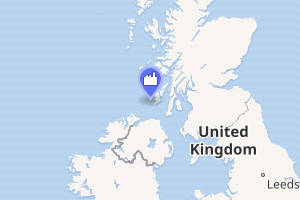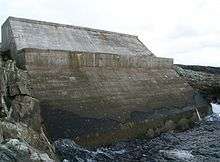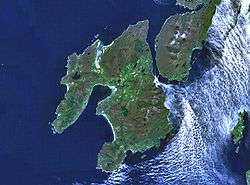Islay LIMPET
Islay LIMPET was the world's first commercial wave power device and was connected to the United Kingdom's National Grid.
| Islay LIMPET | |
|---|---|
 The LIMPET installation in July 2009 | |

| |
| Country | Scotland |
| Location | Islay |
| Coordinates | 55°41′25.56″N 6°31′20.12″W |
| Status | Decommissioned |
| Commission date | 2000 |
| Decommission date | 2012 |
| Wave power station | |
| Type | Oscillating water column |
| Power generation | |
| Nameplate capacity | 250 kW[1] |
History
Islay LIMPET (Land Installed Marine Power Energy Transmitter) was developed and operated by Wavegen in cooperation with Queen's University Belfast. Following the construction of a 75 kW prototype in 1991, a 500 kW unit was built in 2000 at Claddach Farm on the Rhinns of Islay[2] on the Scottish island of Islay. The capacity was later downgraded to 250 kW.[1][3]
Technology

Islay LIMPET is a shoreline device using an Oscillating Water Column to drive air in and out of a pressure chamber through a Wells turbine.[1][4][5] The chamber of the LIMPET is an inclined concrete tube with its opening below the water level. External wave action causes the water level in the chamber to oscillate. This variation in water level alternately compresses and decompresses trapped air above, which causes air to flow backwards and forwards through a pair of contra-rotating turbines.
Decommissioning

The plant has been decommissioned, and as of 2018 all installations except the concrete construction making up the wave chamber have been removed.
Related installations
Based on this design, a 16-turbine plant was built in the Bay of Biscay in Spain, the Mutriku Breakwater Wave Plant, which was fully operational and handed over to the company in 2011.[6]
Footnotes
- "Coastal conversions". International Water Power and Dam Construction. 16 January 2008. Archived from the original on 2012-09-18. Retrieved 2012-03-30.
- Tom Heath. "The Construction, Commissioning and Operation of the LIMPET Wave Energy Collector" (PDF). Wavegen. Archived from the original (PDF) on 2011-06-26. Retrieved 2009-08-04.
- T.J.T Whittaker; et al. "The Limpet Wave Power Project – The First Years of Operation" (PDF). Archived from the original (PDF) on 13 November 2013. Retrieved 17 September 2018.
- "How it works: Wave power station". BBC News. 20 November 2000. Retrieved 17 September 2018.
- Seenan, Gerard (2000-09-14). "Islay pioneers harnessing of wave power". The Guardian. London.
- "Inverness firm hands over the world's first full life wave power plant". Inverness Courier. 17 November 2011. Retrieved 2016-07-29.
